Papa Vinyard here, now here's a little somethin' for ya...
Joe Begos, his buddy Josh Ethier, and a small crew went back to Begos' hometown in Maine with about 30 grand amassed and a horror script called ALMOST HUMAN. What they came up with was able to get into the Midnight Madness lineup at TIFF, putting Begos in the company of dudes like Eli Roth, Lucky McKee, and Alex de la Iglesia. IFC Midnight picked up the film, and is rolling it out in actual theaters instead of only VOD (which, given the terrific, ear-crushing sound design, is a huge plus).
While you can nitpick the film's obvious low-budget nature, I found it to be a well-executed horror flick with a ton of great moments and its heart firmly in the right place. If this flick had a million-dollar budget, I'd say Begos showed a ton of promise and a gift for captivating an audience. Having done it for just over 50 grand? The dude is obviously a talent that needs a bankroll and top-tier talent at his disposal as soon as possible.
I approached Joe after a screening at USC, and he was nice enough to give me about half an hour of his time while jetting around the world promoting his movie. We touch on his efforts to make the movie, his inspirations, his aspirations, and his thoughts on where to take the horror franchises that he (and the rest of us) grew up on.
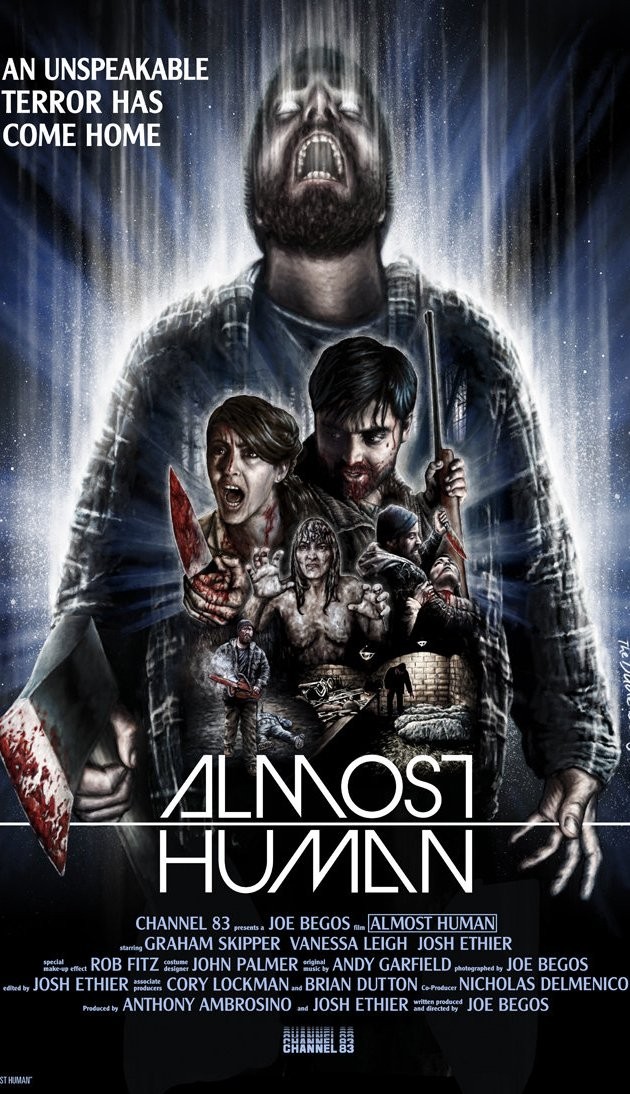
VINYARD: I can imagine you've been doing the rounds with (ALMOST HUMAN) quite a bit, and in particular dealt with this question a lot, but if you could get into your influences a little bit for this movie- just from the poster, you can tell it has a very heavy John Carpenter influence because it kind of invokes THE THING with the imagery of the head splitting, etc. But besides Carpenter, could you go into some of your influences for this movie?
BEGOS: Directly, the two biggest influences were probably FIRE IN THE SKY and THE TERMINATOR. FIRE IN THE SKY to me is just the best alien abduction film I've ever seen. There hasn't been that many. But structurally I just love how THE TERMINATOR works as a screenplay, and it's one of my favorite movies too, so I kind of went with those two as a main influence. I'm such a big horror fan that everything else that I've sponged in over the last 20 years kind of made its way into the movie, even if it wasn't directly intended. So it was 20 years of genre watching building up and exploding into this one movie, you know? I wanted to make a movie for so long that I tried to get everything in. So I think that's kind of why there's so many influences apparent in it.
VINYARD: What about that poster? I guess you guys came up with the poster before you even started selling the film, so who exactly did the artwork for it?
BEGOS: I thought it was important to have a great poster since we had no stars or anything like that, so I contacted Tom Hodge. He did the designs for HOBO WITH A SHOTGUN, THE INNKEEPERS, he did some work for Scream Factory. His stuff has that hand-painted look which I thought was something very important. Basically, what I did was I came up with a look of how I wanted the poster to look, and it was kind of a mixture of THE THING with the original FRIDAY THE 13th, where it had the stalker shape with the action going on inside of it, THE BEAST WITHIN, and SCANNERS. I kind of used those as a reference, and I sent it over to Tom, and Tom came back with a design pretty close to our final poster. There were some minor tweaks, but I gave him what my idea was and he kind of took it and ran. I just blindly e-mailed him, and he was totally down for the poster, which was awesome. I didn't think we'd get him.
VINYARD: What about the music and the font of the credits? Those are also heavily, for lack of a better word, Carpenter-esque. Who composed the music?
BEGOS: The music was done by Andy Garfield, who had done HATCHET 1 & 2 and FROZEN for Adam Green among some other low-budget horror stuff, and he had been a friend of ours, so he was the one we went to. He does all the stuff himself. He can make stuff sound just like he has 30 guys doing the score. So we went to him, and we had a pretty direct temp score in the movie. It hit a lot of the beats that we wanted, it kind of had the mood that we wanted. We gave Andy the film with the temp score, and we let him use that temp score as his foundation to kind of run from there. And you know, I just love Carpenter's synth stuff. It's so simple, but it's so atmospheric. You get such a mood. I wanted something that would feel like that.The other thing is there's a lot of heavy action set-pieces in the movie. For me, that kind of bigger orchestral stuff sounds better for action scenes than synth stuff, so the challenge for us with the temp score, and the challenge for Andy, was using synths to kind of build moods and whatnot, and then getting the bigger stuff for action sequences without making it seem like two different scores, making that seem organic. I'm pretty happy with the way it turned out. I think we got the best of both worlds of what I wanted.
And the font is just something that, since I was a kid- not since I was a kid, but since I started making movies- it's like "If we ever make a feature, we've gotta use the Carpenter font because I just gotta get that out of my system, and when someone sees that Carpenter font, they're gonna go 'OK, maybe I'll give this movie a chance.'" That's how I feel anyway. I've seen a couple movies use it, and right when I see it I'm like, "Alright, at least we're on the same wavelength, so I'm gonna give him a little more of a benefit of a doubt."
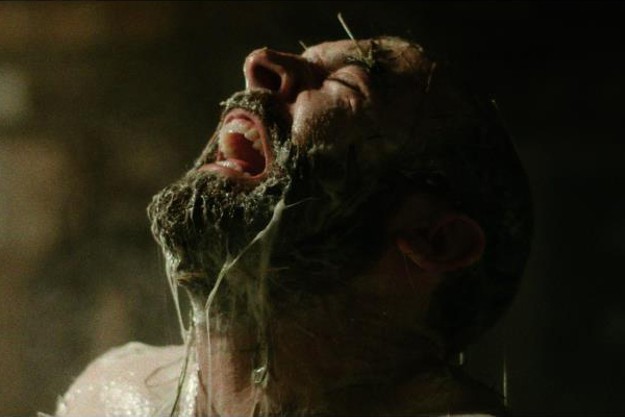
VINYARD: That's exactly how it worked for me. As soon as I saw the font, I went, "OK, I kinda get where this guy's coming from." It's a nice little intro to the mood of the movie. You talked about the action scenes before, and as far as I could tell, there wasn't any CGI used in the movie, is that correct?
BEGOS: There was literally I think about 14 shots where we had mattes removes and shadows removed, but other than that literally everything is all practical through camera tricks, or stunts, or sound design really amping stuff up. Everything was done live on set, which for me is not even a thought. When I write, it's like "This is gonna be done practical." I don't even have to think about even using CG. To me, there's a place for CG, but it's really just to just band-aid and kind of do patchwork on practical effects you already have. The thing about CG is that it works when people don't even know that there's CG, so if you put CG in your movie and somebody's like, "Great practical effects!", you know you've done a good job. I think Guillermo Del Toro really does it the best. He melds top-of-the-line practical effects with CG, and it's just fucking insane, but on a $50,000 movie, CG's not gonna look very good.
VINYARD: That's the thing! I saw 300 the other night, and that's a $110 million movie, and there's not one convincing gore shot in the movie because it's all CGI. You're movie's made for 60 thousand dollars, and you see it, it's there! You don't have to polish it or finesse it (in post), because you did it on set, and what I'm wondering is if you get a bigger budget for your next movie, which presumably you will, are you still gonna stick to your guns and maybe go as practical as possible?
BEGOS: Oh, yeah, 100%, because here's the thing. The argument point that I use is, people say "CG's so much faster," but you know what? It's not. If you spend the extra day or two on set to get exactly what you want practically, then you have zero days of people working in front of a computer. When you have 10 guys working on a computer 20 hours a day, that shit adds up. It's a lot more expensive than spending an extra day trying to get the practical effects ready. The other thing about CG is you have those 10 guys spit something out, and it's probably gonna look like shit, and that's what you get, whereas practical effects, "Oh, this doesn't look good, let's adapt and shoot it this way." So you figure out on set how to make it work, and then it's in the can, and you have no additional work to do for that scene. Having done this for so low-budget and pulling off all the practical effects, I feel like I have a really good arguing piece for my next movie where I can say, "No, this is how this works. This works better because of this, and this is how we're gonna do it."It blows my mind. It's like you said, 100 million dollar movies can't get CG right, so if it won't work with millions of dollars behind it, what the fuck makes anybody think that it's gonna look good in our movie, you know what I mean? And I think it's a good way to stick out, you know? This movie's all practical, which maybe gives you a little bit of an incentive to go check it out, hopefully.
VINYARD: Absolutely. You said the budget was 60 grand, right?
BEGOS: It was 50.
VINYARD: 50, ok. You shot in the northeast, right?
BEGOS: Yeah.
VINYARD: And with the RED, and with a bunch of basically unknown actors. How hard was it to basically sell your movie to raise the budget?
BEGOS: The budget was basically me and the producing partners seeing how much we had in our savings accounts and how much we could get on credit lines. We literally went to a bunch of different credit card companies, and applied for as many credit cards as we could. We got almost 20 grand on credit cards, so it was like, "Alright, that's a 20 thousand dollar investment in the movie." We actually shot the movie for a little bit under 30 grand, because that's…what we could get. So we were like "Let's get this movie in the can. We can definitely do it for this amount. We'll worry about raising the rest of the money later once we cut the movie." We got it in the can, and we cut it together, me and Josh (Ethier) in the apartment. We had no more money to put into it, but what we did have was an edited movie that we could say, "We need X amount more to finish this, here's the product." It's a guaranteed movie to finish. From there, we were able to find 14 or 15 more investors who gave tiny amounts of money to help seal the deal.So the raising the money part was actually a lot easier than I thought, just because we had enough to get the movie in the can, and then raising the money off the semi-finished product was a lot easier. Selling the movie was a little bit harder. It was hard to get people to take a look at it, just because it's such a low-budget movie with no name actors, no name crew members or anything like that. The thing is, once you get your movie in front of the right person, that makes a world of difference, so month after month, we were trying to get it in front of sales agents, festivals, and it wasn't working out. We finally found a great sales agent who really saw the potential of the movie, and really pushed and put all his weight behind it, and that helped kind of open the doors for us, and eventually got us into a big festival. Once you get into a big festival like that (laughs), it becomes a lot easier. Suddenly people want your movie. Which is awesome.
VINYARD: So how'd it feel to be part of the Midnight Madness lineup at Toronto back in September?
BEGOS: It still kind of feels like a weird dream. That's a festival I've always wanted to go to since I was a kid, and you know, CABIN FEVER blew up there, HIGH TENSION, and all these movies that I loved. The best movies coming out for me, when I was 13, 14, all premiered there, so it was kind of like, "Maybe on our fourth or fifth movie, Colin (Geddes) will take a look at it." But to have our first movie there, on such a low-budget, and then we're premiering in the same lineup as Lucky McKee, and fuckin' Eli Roth, and Alexandre Aja's movie was at Toronto, not at Midnight Madness, but it was there. It was just like, "What the fuck is going on?!" Even now, I'm like, "Yeah, that couldn't have happened. What's going on?" It almost feels like a peak, like "Where the fuck do I go from here?" It's definitely a weird feeling, very surreal. So hard to believe.
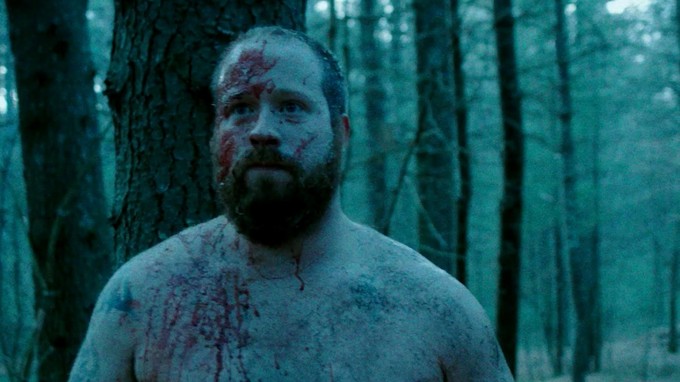
VINYARD: Yeah, I can't even imagine. So Josh Ethier you said you guys were onboard together on this project from day one. He produced the movie, he edited the movie, he's basically the lead, or the co-lead, of the movie.
BEGOS: He's the Schwarzenegger of the movie. (laughs)
VINYARD: Did you know he was going to be your Arnie from day one?
BEGOS: We've been working together for about 10 years or so, and he has such good screen presence. I knew he was going to be on set getting his hands dirty behind-the-scenes with me, it just made sense to put him in front of the camera too. It's like, "You're gonna be there that entire time with me, why bring somebody else out? You can do it just fine. I know your strengths, we have a shorthand, this just makes sense." I actually wrote the script with him in mind, and I didn't tell him that I was writing him to be the main villain until he read the script, so it was probably a welcome surprise for him.
VINYARD: Probably flattering, huh? Until he got to the naked scene in the snow.
BEGOS: Yeah, he was probably the only person who would've done that scene.
VINYARD: But there's another really pronounced little bit of nudity towards the end with, to avoid spoilers, I'll just refer to it as "tentacle rape."
BEGOS: Yeah. Maybe we should refer to it as "tentacle porn," because rape is a strong word. I've been getting a lot of shit for that.
VINYARD: Okay. "Tentacle over-extension of affection," let's say. But can you get a little bit into what it was like to shoot that scene?
BEGOS: The actress was so down to do it, but then there's always this nagging fear. You hear people say that people hop out of movies at the last second. And this movie, having nothing else going for it, we need that one shock moment, that one RE-ANIMATOR moment, that MANIAC moment, that one moment you'll remember from the movie. It was so important to me to get it, and it was so nerve-wracking that whole night. No one could be on set. It was so hot in that room because she was naked, so we needed to have heaters in there, and Josh was sweating and dripping all over the place, the appliance didn't work. And then once we finally shot it, and I knew I had one shot of it, I was just like, "Oh, thank god, this is going to be in the fuckin' movie now." Then we just went with it and tried to get as much footage and angles as we could before she was finally like, "You know, I can't do this anymore." It was pretty weird to be looking through this giant RED camera into the eyepiece, and then you see that. (laughs) It was fun.
VINYARD: I imagine it was fun to edit.
BEGOS: Yeah, 'cause you gotta be tasteful too. We had a lot of different combinations on how to make that work, but I think the way we got it onscreen is pretty good.
VINYARD: Oh yeah. It definitely works as the shock moment you're referring to. There was an audible gasp when we saw it at USC. You shot the movie, you produced the movie, you wrote the movie, you edited the movie, and you directed the movie, right?
BEGOS: Yeah.
VINYARD: Was that all a necessity of the style of the production and the budget? Or do you think next time around you're gonna take on just as many hats?
BEGOS: Writing, producing, and directing was a definite from the get-go, because I just love writing my stuff. I can write to my strengths. Producing it, same thing. You gotta "produce and protect." The cinematography thing just came out of necessity, because I've used a cinematographer in my past few shorts, but I always operate the camera, I always storyboard everything the way I want it, I pick the lenses. The guy who I wanted to use as my D.P. was like, "To be honest, I'm just a glorified gaffer. I don't want to come on and do this movie as a glorified gaffter." Then I started hiring other D.P.s, who would start saying the same thing, and were very interested in operating and all this stuff, so I just said "Fuck it," you know? "If these guys think that what I'm doing is D.P-ing, then I'll just fuckin' D.P. the movie." I got a really good gaffer, and I went and operated and shot the movie. It doesn't look amazing, but I feel pretty good about the way it looks. Depending on the next movie's budget, I may or may not shoot it. There's quite a few D.P.s that I would love to work with, it's just a matter of whether I can afford somebody that would be able to elevate what I want to do. It really depends on the budget of the next movie, but if it's really low, I feel confident enough where i could shoot it again, so it's a project-by-project basis, I guess.
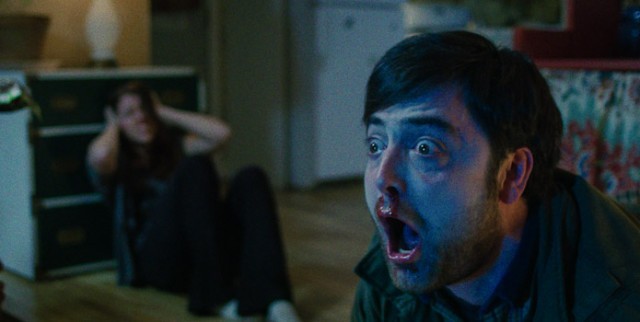
VINYARD: Besides Josh, how did you get your other actors? Were they friends of yours? Did you get them around the location?
BEGOS: Graham was somebody who I was working with on RE-ANIMATOR: THE MUSICAL. I wrote the script with him in mind, and then I gave him the script and asked him to do it, and he was super-excited about it, thankfully. Everyone else we cast in Rhode Island. They were all non-SAG, and the thing it not all of them are professional actors, they were just blue-collar people working in this town, so it adds some realism to the film.
VINYARD: So you worked on RE-ANIMATOR: THE MUSICAL. What was it like working with Stuart Gordon? How long did you work for him, and in what capacity, and what influence do you think that had on your work?
BEGOS: I started as an intern, reading scripts for him, and kind of helping him develop stuff. Then he started doing stage shows, he wanted to do NEVERMORE as a one-man show with Jeff Combs, and I stage managed that. After that, he moved on to RE-ANIMATOR, and I stage managed that for about a year. The biggest thing I took away from it was being able to see how he works with actors, how he works with ensembles, how he works with single actors, how he structures things, how he plans out beats. I just literally watched him direct for two years. The things you take away from that are ridiculous. He was able to take a look at my scripts, and help me out with structure and story, and helped to elevate my writing skills beyond what they were, which weren't very good.
VINYARD: What's your personal favorite Stuart Gordon flick?
BEGOS: FROM BEYOND.
VINYARD: Nice! Me too.
BEGOS: RE-ANIMATOR is a close second, but FROM BEYOND holds a soft spot in my heart.
VINYARD: The Ken Foree in there.
BEGOS: Yeah, exactly.
VINYARD: I guess at some point when you were making the movie, you realized this is heavy Cronenberg, Carpenter, FIRE IN THE SKY, TERMINATOR-influenced movie, and it was kind of an amalgamation of all these things that have been cooking in your brain for all this time. Was your goal to kind of throw your hat in the ring and bring something new to the table, or was it, with your budget and your scaled down crew, to just try and approximate that. Would you have been happy just to have made a good Carpenter movie, or did you want to make a good Joe Begos movie?
BEGOS: I wanted to make a good Joe Begos movie, but being so new, I don't have a whole lot of life experience. My experience mostly comes from movies. Francis Ford Coppola always said, "You start out by stealing from the best, and then you find your own style in that way", and I've tried to do that in shorts, and am trying to find my own way in features. This being my first movie, there were so many heavy influences that were apparent, and I think that now I've gotten it out of my system it's going to go forth and narrow that down to my own style. It wasn't like, "I want to make a good Carpenter or Cronenberg movie." I wanted to make something that was heavily influenced by them, but then was kind of doing its own thing. Like how those guys were influenced by people in the '50s and '60s, William Castle and people like that, and then they kind of went on and made their own things. I see so many people saying, "This movie isn't THE THING, fuck this guy! He's not John Carpenter!" And it's like, yeah, but THE THING was Carpenter's 8th movie, he had like 12 million dollars to do it. When you compare it to DARK STAR instead, the distinction is a little murky.
VINYARD: You gotta compare it to the beach ball monster.
BEGOS: Exactly. It doesn't make sense.
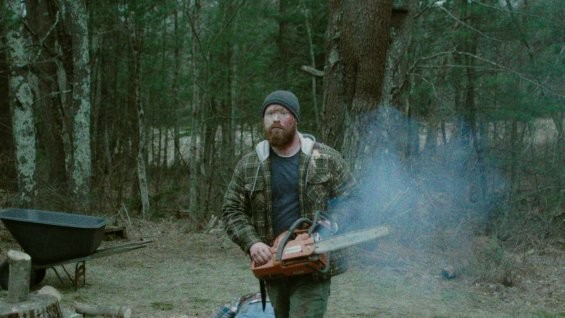
VINYARD: Because it's so on-the-sleeve influenced by Carpenter and Cronenberg, it provides a great little hook. Like you said, people notice it immediately, when they see the font, they get an idea of what the movie is, when they see the poster, they get a very clear idea of where it's coming from. No doubt, and I think you'd agree, this helped you get traction for this movie. It helped get it to where it is today, which is a great place. What would your advice be for young filmmakers who are looking for their own hook? 'Cause you know so many kids go into it very ambitious, and they have their own personal idea of what it's going to be, and of course they can't reconcile that with commercial interests. What's your advice for young filmmakers looking for their "hook" to get financers, investors, and of course audiences interested in their debut work?
BEGOS: Just keep on writing, keep on making stuff. We're in a time when you can make stuff for so cheap. We made 15, 20 shorts before this, and if I made a feature without having made any shorts, it would've just been a pile of shit. Using this feature, i was able to take everything I know I could make work from shorts, everything that I've learned works in shorts, and tried to make a greatest-hits I guess. "I know this will be executed fine, I know that this will work," instead of being on set for the first time and being like, "Oh, geez, I hope this works, I hope this works." There's so much that can be said for just going out there. You can film shit with your friends every weekend, and the experience and the shit you learn from that is going to be so amazing. The fact that I shot these shorts before, it allowed me say, "I'm confident enough that I can shoot this movie. I've done this before." Where if I had never done this before, I would've been pissing my pants.The most important thing is just to keep writing, keep writing, keep writing keep making shorts, keep making shorts, and then when you get to a point where you'll be like, "I think I've hit my wall with shorts, I think it's time to step up my game." That's what happened to me, and I think that generating content nonstop is the best thing anybody can do. If you're a filmmaker, or you want to be a filmmaker, just become a filmmaker. Just pick up a camera and do it.
VINYARD: Makes me think of EVIL DEAD, 'cause obviously Raimi and Bruce Campbell and Rob Tapert and all those guys were doing shorts for years, but when they did WITHIN THE WOODS…it's kinda not that great. I mean, it's good, but it's not EVIL DEAD. You're just seeing them tool around out there. But there's no doubt that without that movie, they wouldn't have been able to make EVIL DEAD.
BEGOS: And it's because of that movie that they looked at it and went, "Hmm, what can we do better in the feature version?"
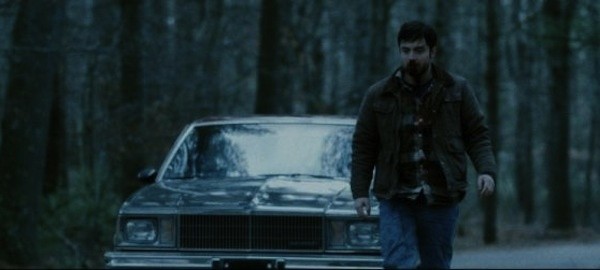
VINYARD: Exactly. It gave them a jumping off point to make EVIL DEAD. You gotta start somewhere. Last question: the movie ends pretty definitively for a horror movie, especially a horror movie with sci-fi leanings could be more open-ended, but you've expressed some interest in doing a sequel. Could you dive in a little bit into your ideas for the sequel?
BEGOS: My idea for the sequel…I'd have to try and figure out some way to bring Mark, because I think that would add a cool angle to the sequel. But ultimately, a certain character died at the end of the movie, and yet it would be that the alien pod infected his body. He wakes up in the morgue, and he infects everybody in the morgue, so it just turns into a giant infestation of the alien pods. Then they all explode out and take over the hospital. It's like HALLOWEEN II meets ALIENS, I think would probably be the best way to describe it, and I'm hoping that we'll get more money for it and really splatter some shit around and up the ante.
VINYARD: Hell yeah. Besides that, do you have anything else on your plate?
BEGOS: I wrote a script for a telekinetic revenge movie, and it's essentially SCANNERS meets DEATH WISH. It's a really brutal sci-fi, '80s-style telekenesis movie. Hopefully I can get money for that. I need a little bit more, but not too much, so I'm kinda hoping that comes through and I can be on set again. I'm getting really antsy.
VINYARD: I love that it's all been original stuff. There's no Lovecraft adaptations, or anything like that. It's all been your original output. If you were going to adapt something, either a remake or an adaptation of a book, what do you think it would be?
BEGOS: If there's any movie to remake, or not even do a remake just do another installment of, I would absolutely love to do a FRIDAY THE 13TH movie. As much as I love those movies, there hasn't been one that's been like, "OH MY GOD! THIS IS AMAZING!" I feel like if they went back to the roots, and made an '80s style camp counselor fucking hardcore splatter movie with Jason Voorhees for low-budget, I would be all over that. I also think there's room to do another killer NIGHTMARE ON ELM STREET movie, not necessarily a remake, but just another installment in that canon. HALLOWEEN I think is too perfect to touch. There's nowhere you can go with that. But if I could get free reign on one of those first two, I think that that would be fuckin' awesome.
ALMOST HUMAN is currently playing in Chicago and Toronto, and premieres this Friday (3/21) in Phoenix, and next Friday (3/28) in Seattle. For updates on where ALMOST HUMAN is playing in theaters, check out the film's Facebook page and Joe Begos' Twitter account.
-Vincent Zahedi
”Papa Vinyard”
vincentzahedi@gmail.com
Follow Me On Twitter
